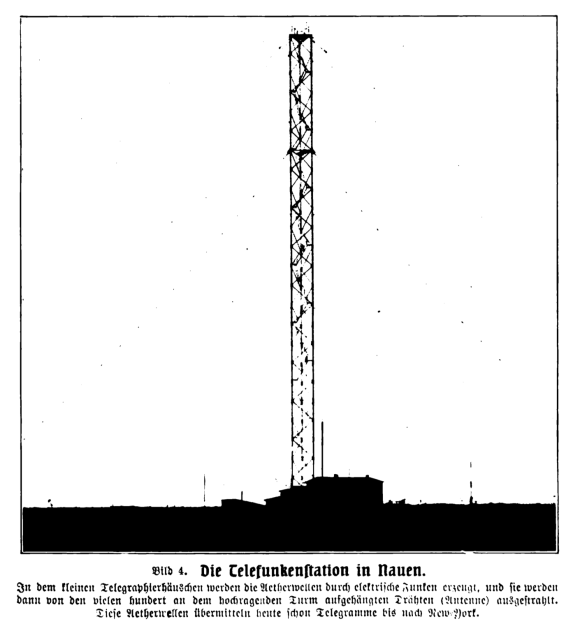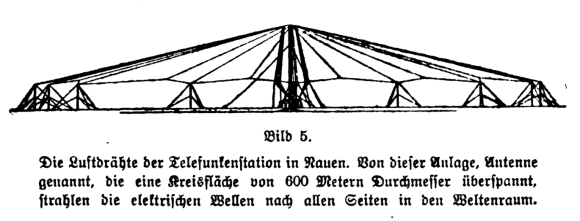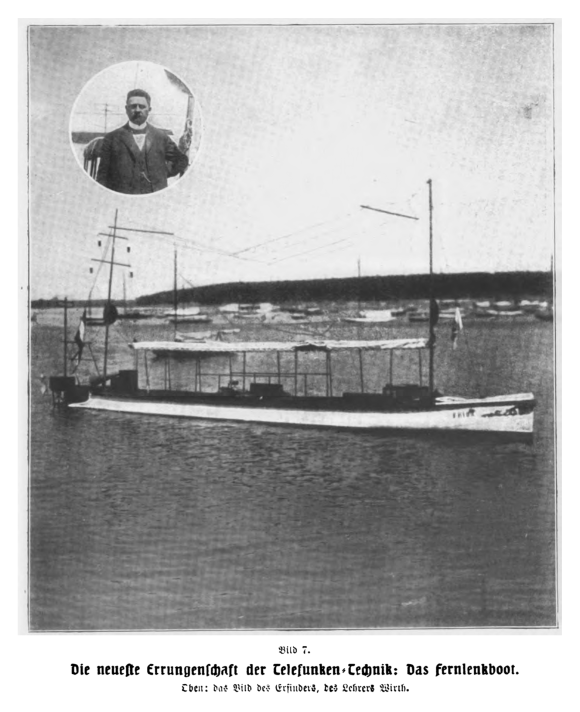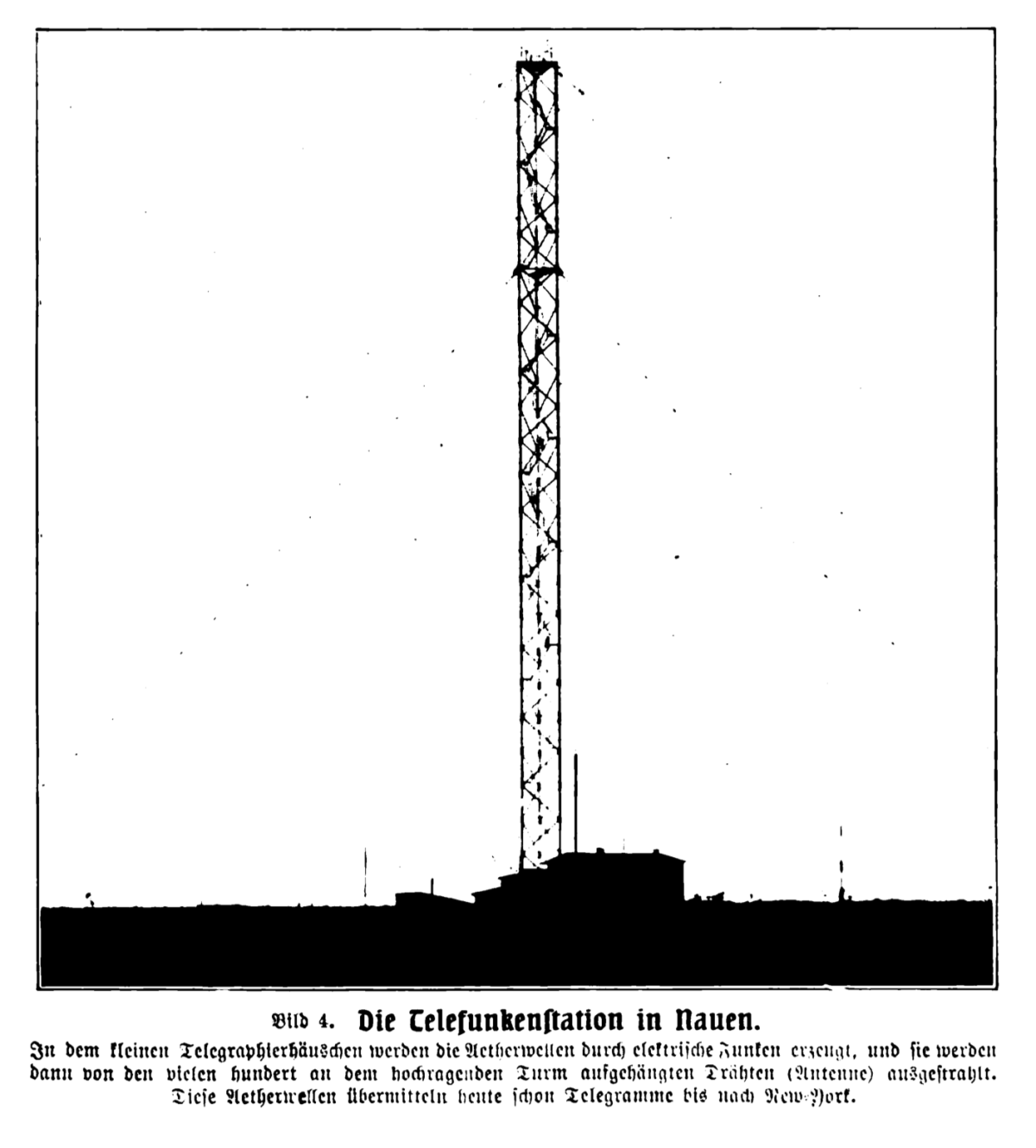The other day a ship arrived in the port of New York, its passage from Europe to America constituting an important event in the history of technology. The steamship Bosnia carried on board a station for wireless telegraphy, and, with its help, it was possible for the first time to create a wireless telegraph connection from the suburb of Nauen near Berlin to the immediate proximity of the port of New York.
During its entire passage across the ocean, the Bosnia stayed in contact with the Telefunken station at Nauen. However much the ship’s propeller churned up the ocean, however many hundreds of kilometers the steamship put behind itself and the coast of Europe, it kept pulling along the power of ether waves mysteriously in its wake, and the little apparatus in the telegrapher’s cabin kept reporting with its sharp, clear tick-tock, tick-tock, the contents of the newest newspaper dispatches with the same clarity you would expect traveling across the English Channel or in view of the Statue of Liberty.
The distance from Nauen to New York amounts to 5,200 kilometers. It would take six to seven days to cover it using the fastest means of transportation for people and goods. An electric vibration travels from Berlin to the American coast in a fraction of a second, and it will not even be tired when it finally arrives, performing the task it was entrusted with on this side of the ocean both powerfully and willingly.
What tremendous power! And who is its master?
A man in a blue shirt sits in the humble, whitewashed room of a little country house, holding a smoky, short-stemmed pipe in one hand, and casually moving a delicate switch, a telegraph key up and down with the other. This movement occurs in a particular rhythm in which the trained ear can discern the letters of the Morse alphabet, which, as you know, is composed of combinations of short and long electrical currents. The man at the button is an ordinary telegrapher, and does not exert any more intellectual or physical energy on his work in the little room in Nauen than he would were he to send a telegram over the Imperial Prussian wire from the location of the post office in Treuenbrietzen to Füterbog.
However, the steamship Bosnia is traveling to the port of New York, 5,200 kilometers away, and the cool-headed man with the short-stemmed pipe can transmit the newest messages from around the world to that place across land and sea, across mountains and valleys and storm-tossed waves. What gives him this power?

If we step out of the little house into the open air, we will immediately see the Nauen telegrapher’s powerful assistant. There is suddenly, in the middle of the unspeakably flat Märkisch landscape that sprawls for miles in horrifying silence, a quite thin, very high tower (fig. 4), erected like a harsh exclamation point. It rises up a hundred meters, sticking out considerably above many church spires. Attached to the top of this tower is a web of wires that spreads out in every direction, and that, seen from below, resembles a very delicate spider’s web. From above, the web of wires contracts and expands in the most manifold connections and interlacings, until its last branch terminates in a row of low steel masts that are positioned in a circle at a distance of three hundred meters around the tower. This web is called an “antenna” (fig. 5), and it is the true master of the universe, because the movements the telegrapher makes in the little room closing an electric current with the key only serve in charging the antenna for a shorter or longer time with powerful electric impulses.

Every time the telegrapher presses down the key, a 100,000 V current gets shot into the antenna, and since this current does not flow directly but alternates many thousand times per second, it creates in the web of wires movements of the ether we call “electric waves”. They propagate into space in all directions with a speed of 300,000 km/s, and nothing is able to stop them en route—no storm, no mountains, no object, and no event. They will also make it from the tower at Nauen to the Telefunken station on board the steamship Bosnia, which is just arriving in the port of New York, and they are able to create dots and dashes, the letters of the Morse alphabet, on a moving paper tape with exactly the same rhythm as the Nauen telegrapher presses down his little button for a shorter or longer amount of time.
Nowadays people are already accustomed to counting on wireless telegraphy as a matter of fact, to viewing it as one among humanity’s many possessions. The legions of the mindless already find nothing special about it other than that you can send messages from one coast of the ocean to the other without any connecting wires, just as, a few months after the invention of television, these same people will consider it to be self-evident to be able not only to speak with their dear uncle in Kyritz over the wire but also to see him in the flesh hundreds of kilometers away.
On board the steamship, there is a small glass tube filled with fine metal filings, which completes a local circuit whenever electric waves hit it, and this little tube, called a “coherer”, makes the massive cables, which cost millions, redundant! It is the most sensitive construction that exists, and it will soon be able to detect ether waves around the entire circumference of the earth.
Because people will not be content with the route from Nauen to New York. In 1906, the large German Telefunken station had a range of 3,600 kilometers, which means that its telegrams were received at Tenerife [in the Canary Islands]. In 1909, Nauen was already sending its electric waves 4,500 kilometers away to Capo Blanco [in Mauritania on the west coast of Africa], and, in 1911, they reached 5,200 kilometers.
The main reason for the expansion of transmission range is the increase in the electric energy of the station’s engine room, along with refinements of many individual apparatuses. At first, people worked with an engine with 35 horsepower. Today, there is a motor with hundreds of horsepower. It would be nothing to increase the horsepower many times over, but unfortunately the corresponding increase of voltage in the antenna’s oscillating current would be unworkable.

For the problem of isolation already presents significant difficulties. In the Nauen telegraph house, the 50,000 V electric current created in the engine room, which can easily be transmitted, charges a powerful battery made of Leyden jars (fig. 6). If the current discharges, then oscillating electric sparks of 100,000 V, which create the vibrations in the ether, will jump the gap between a number of metal plates countless times per second. At the site of the wireless station, the antenna, which is attached to the tower outside, serves as a conductor for these spark gaps, since the network of wires leading up into the air increases the range of the vibrations enormously. At the place where the connecting wire passes from the spark gap to the antenna through the wall of the house, there is already, even at the present voltage, a huge porcelain isolator with a length of two meters (fig. 2). It keeps the 100,000 volts in check. There’s no way of managing a higher voltage. So, this constitutes a limit for the time being.


However, there is no doubt that the work already in motion will make it possible to keep increasing the voltage. And then wireless telegraphy will continue its victory march.

In the meantime, the power of ether waves has already conquered a new domain. On the Dutzendteich Lake in Nürnberg and the Wannsee near Berlin, you can see a motor boat driving around whose movements are controlled from the shore (fig. 7). Nobody is on board, and the turning of the helm, the starting and stopping of the machine, the discharge of warning signals for approaching ships—everything is brought about from dry land. It is a really strange, very wonderful sight to see the boat gliding through the water so sure of its goal without any crew, and the occupants of a passing steamship or a sailing yacht, none the wiser, must be as startled at the sight as if Hauff’s ghost ship were suddenly passing by.
The magician here, too, is the waves of the ether. On the shore, there is once again an antenna hung up on a high mast, and, just as in telegraphic communication, the electric vibrations sent through the antenna influence a coherer on board the ship, which is connected to a receiving antenna secured between the ship’s masts. Whenever the antenna on shore sends out vibrations through the push of a button, the coherer on the ship completes circuits that are fed from storage batteries on board.
In and of itself, it is not difficult to bring about effects like turning a steering wheel or stopping a gas motor through the completion of various circuits. What is surprising about this remote-controlled boat is that the steersman on the shore is able to complete various circuits according only to his own desire using the influence of the one coherer, which, of course, is the only one he can use—that is, using a circuit at one single location. One push of the button on dry land and the wheel turns to the left, another push, and, with that, the antenna influences the coherer, and the warning signal sounds, then the wheel holds course or the motor suddenly stops.
Merely reporting the fundamental idea of the invention would not do justice to either the event or the inventor, the teacher Wirth. For the time being, it can remain his secret. There are no small number of possible uses for this invention—admittedly, only after further perfection in practice. The navy would be able to use torpedoes without launching tubes and without even needing to shoot them—simply put them in the water, since they could be controlled wirelessly from on board a ship to reach their target. People would also be able to send a rescue boat to anyone in danger on a stormy sea without endangering any of the rescue party. And the perfected invention would also open up many further fields of application.
Admittedly, it is first necessary to tune the receiving apparatus on board to the point where it would only pick up oscillations from the intended antenna. Otherwise, for example, one side in a naval battle would be able to easily defend themselves using the oscillations coming from their enemy’s antenna. For this situation, Wirth also claims to have found a solution.
The telegraphers at Nauen are also working on the problem of keeping their messages secret by tuning their apparatuses to particular wavelengths. Some of them have already succeeded, but there’s still a long way to go here, as is the case for the other Telefunken stations. For the time being, Nauen’s enormous range, as great for receiving as for transmitting, is able to capture any wireless telegram transmitted anywhere in Europe. It is almost omniscient: It knows everything that plays out in the ether.
Source: Artur Fürst, “Die Beherrscher des Weltraums,” in Die Wunder um Uns: Neue Einblicke in Natur und Technik, 11-20 (Berlin: Vita, 1911).

